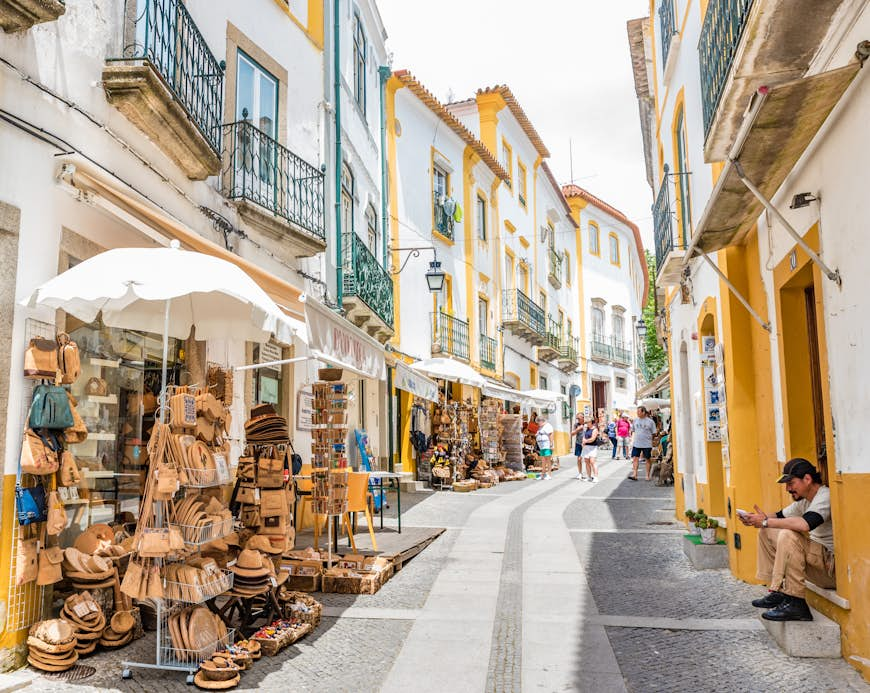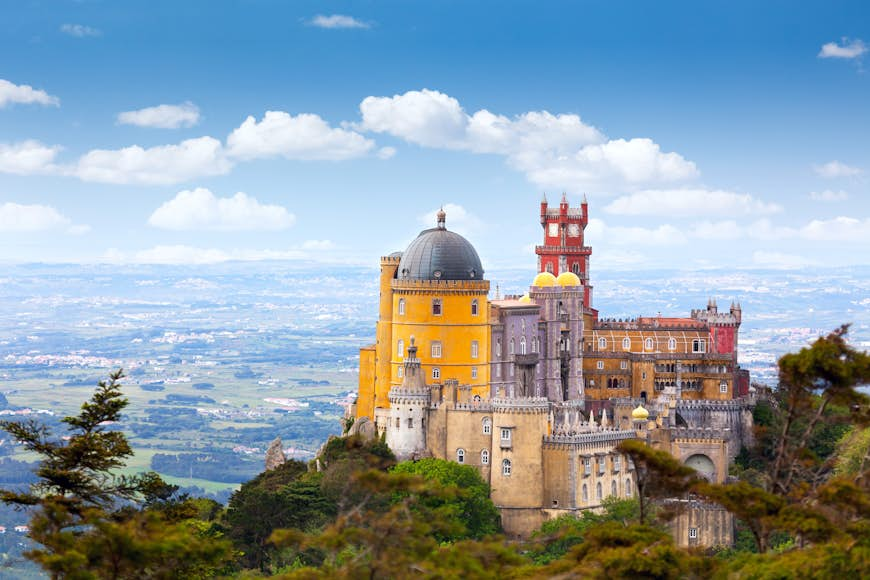Lisbon and Porto get all the love, but there’s much more to Portugal than its captivating historic cities. Golden beaches, mountainous parks and lush river valleys are among the many highlights of this small Iberian nation.
Every region has its own diverse attractions, and finding the best place to go depends largely on your own interests. If you’re after sun-kissed beaches and aquatic adventures, look to the Algarve; for historic architecture-filled towns with a rich, traditional dining scene, make your way to Évora. Here’s a rundown of the top places to visit in Portugal.
Lisbon
Best for nightlife
Seven iconic hills overlook Lisbon‘s postcard-perfect panorama of cobbled alleyways, white-domed cathedrals and grand civic squares – a captivating scene, crafted over centuries. The Portuguese capital is packed with galleries to browse (including the Museu Nacional do Azulejo with its trove of ceramic tiles) and castles to explore (such as the hilltop Castelo de São Jorge).
And the city has enough pastel de nata (custard tart) spots to satisfy even the most sweet-toothed visitor. By night, Lisbon’s party people take over, filling old-school drinking dens, brassy jazz clubs and open-all-night clubs that burst into life once the sun goes down.
Setúbal Peninsula
Best for wild, cliff-backed beaches
South of Lisbon, the Setúbal Peninsula has long been the weekend playground of Lisboetas (Lisbon residents). A ferry ride, followed by a short bus or bicycle ride, takes you to the Costa da Caparica, a seemingly endless beachfront that gets wilder and less crowded the further south you go. If you want a surf lesson, some downtime on the sands or a meal overlooking the lapping waves, this is the place to come.
If you’re seeking a bit more solitude, head down to the Parque Natural da Arrábida at the southern end of the peninsula. Here, you’ll find cliffs covered with thick vegetation, picturesque coves and beaches such as Praia do Portinho da Arrábida, with fine sand, azure waters and the ruins of an ancient site that dates back to Roman times.
Sintra
Best for a fantastical escape
Less than an hour by train from the capital, Sintra feels like another world, and it’s a great option for a day trip away from the city hubbub. Like a setting from a fairy tale, this historic hillside township is sprinkled with stone-walled taverns and lorded over by a multicolored palace.
Forested hillsides form the backdrop to this storybook setting, with imposing castles, mystical gardens, strange mansions and centuries-old monasteries hidden among the trees. The fog that sweeps in by night adds another layer of mystery; cool evenings are best spent by the fire in one of Sintra’s many charming B&Bs.
The Minho
Best for traditional villages and wilderness trails
The Portuguese have a special fondness for the Minho, a verdant region of vineyard-covered valleys, mountainous wilds, isolated beaches and picturesque river towns that seem little changed by time. The gateway to the region is Braga, a city with Roman ruins, a fabled medieval cathedral and tranquil flower-trimmed plazas sprinkled with outdoor cafes and restaurants.
Further north, you’ll find Parque Nacional da Peneda-Gerês, a vast, rugged wilderness of dramatic peaks, meandering streams and frozen-in-time stone villages. Dozens of hiking trails crisscross the reserve, taking walkers past old Roman roads, castle ruins or sparkling waterfalls. You can also cool off in idyllic swimming holes – one of the best places to be in Portugal during the summer.

Porto
Best for urban exploring
It would be hard to dream up a more romantic city than Porto. Portugal’s second-largest urban center is laced with narrow pedestrian lanes, baroque churches and cafe-dotted plazas, leading the eye down to the Duoro River and its landmark bridges. Needless to say, there’s no shortage of things to see and do. Start in the Ribeira district – a Unesco World Heritage Site – then cross the bridge to explore centuries-old port wineries in Vila Nova de Gaia, where you can sip the world’s best port.
You can also learn about Porto’s history (both the drink and the city) and other facets of Portuguese identity at the World of Wine, a sprawling complex of museums, restaurants and bars overlooking the city. Though Porto is defined by its air of dignified history, modern architecture, cosmopolitan dining, vibrant nightlife and artistic activity are injecting new life into the city.
Douro Valley
Best place to drink in fine views (and wine)
One of Portugal’s most beautiful areas lies just east of Porto. Here, the meandering Rio Douro flows past towering hillsides covered by the steeply terraced vineyards that make up Europe’s oldest demarcated wine region. Whether you come by boat, train or car to the Douro Valley, you’ll be rewarded with astonishing views at every turn, especially as you near the lovely village of Pinhão in the heart of the region.
Many travelers dash in on a quick day trip, but to make the most of the region, spend the night at one of the vineyard-surrounded guesthouses in the area such as Quinta Nova or the Casa Cimeira.

Évora
Best for historic architecture
The heart of the Alentejo region, Évora is one of Portugal’s most beautifully preserved medieval towns, and it’s an enchanting place to spend a couple of days. Inside the 14th-century walls, narrow, winding lanes lead to striking monuments, including an elaborate medieval cathedral, Roman ruins and a picturesque town square. But this isn’t a musty museum piece – Évora is also a lively university town, and its many restaurants serve up some excellent, hearty Alentejan cuisine.
Coimbra
Best for a student vibe
Portugal’s most atmospheric college town, Coimbra rises steeply from the Rio Mondego, and its handsome medieval quarter houses one of Europe’s oldest universities. Students roam the narrow streets clad in black capes, while the sound of fado (Portugal’s soulful traditional style of music) drifts through the Moorish town gates towards the stained-glass windows of the historic Café Santa Cruz.
Grown-ups will appreciate the town’s student-driven nightlife and the medieval lanes of the steeply stacked historic center. Visitors with younger kids can keep busy at Portugal dos Pequenitos, a theme park with miniature versions of Portuguese monuments.

The Algarve
Best for a relaxing family holiday
Sunseekers have much to celebrate in Portugal. Along the south coast, the Algarve is famed for its gorgeous and varied coastline, and you can join the crowds on the people-packed sands at major resorts or find seaside peace on dramatic wild beaches backed by wind-carved cliffs. Days are spent playing in the waves, taking long oceanfront strolls, or surfing some of Europe’s most memorable breaks.
The Algarve is also one of the best places in Portugal for kids. You’ll find family-friendly beaches, water parks and plenty of outdoor adventures (from boating to hidden sea caves to exploring undeveloped islands). There’s never a bad time to visit this region, with its 300 days of sunshine each year, though you’ll find the best prices and thinnest crowds in winter.
Parque Natural da Serra da Estrela
Best for hiking and alpine activities in winter
The Serra da Estrela – Portugal’s highest mountain range – is the place to come for rugged scenery, outdoor adventures, and glimpses of a vanishing traditional way of life. Hikers can choose from an expansive network of high-country trails with stupendous vistas, and the region’s fascinating mountain villages make perfect bases for outdoor adventures.
At the country’s highest point – the summit of Torre, artificially pushed to 2000m (6561ft) by the addition of a not-so-subtle stone monument – you can slalom down Portugal’s only ski slope. Oh, and did we mention the furry sheepdog puppies that frolic by the roadside? You’ll long to take one home!

Óbidos
Best hilltop village
Wandering the tangle of ancient streets in the historic town of Óbidos is enchanting at any time of year, but come during one of its festivals and you’ll be in for a special treat. Whether you fancy the idea of a mock-up jousting match at a medieval fair, searching for the next Pavarotti at the Festival de Ópera or delving into the written world at Folio – Portugal’s biggest international literature festival – you couldn’t ask for a better backdrop.
